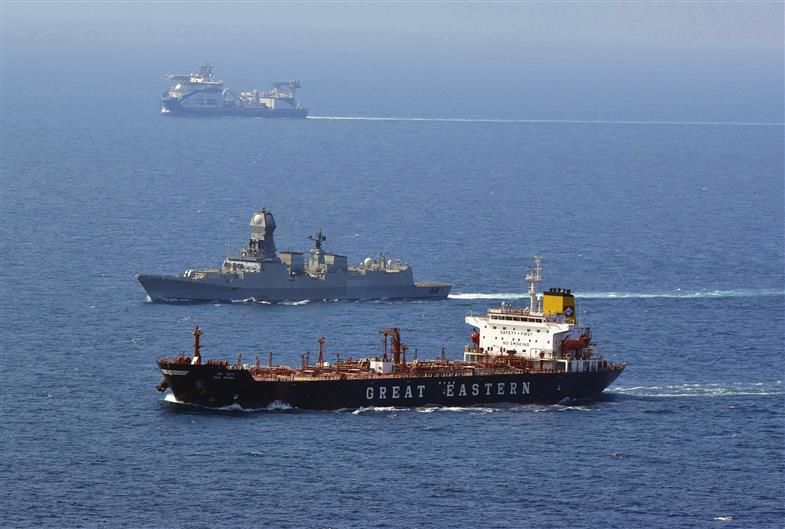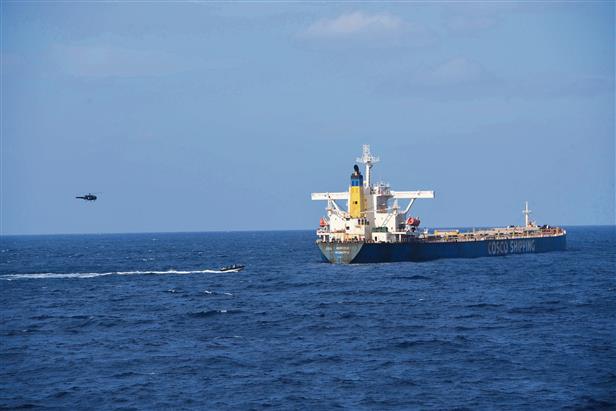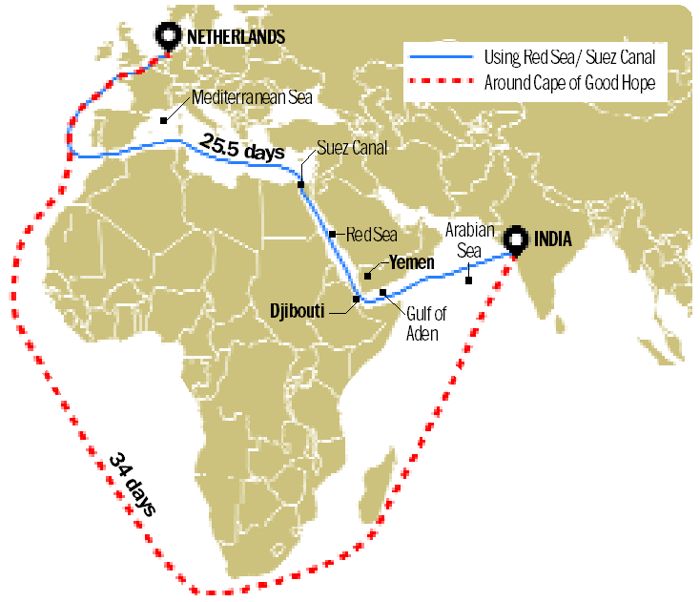
Ajay Banerjee
With Indian sea trade facing increased threats from Somalian pirates and Yemen-based Houthi rebels, the Indian Navy has heightened its presence in the Arabian Sea and is now fielding its biggest peace-time deployment at sea. Its warships are aided by live feed from powerful long-range UAVs and maritime surveillance planes that keep a 24×7 eye on the sea trade routes. India’s 95 per cent trade and more than 80 per cent of its hydrocarbon imports — crude and natural gas — are routed through the sea. Also, with more than four million fishermen, India is the second largest fish-producing nation in the world. In these past six weeks, the Navy has gone up from having two warships, positioned for years in the Gulf of Aden and at the mouth of Persian Gulf, to fielding 12 ships on patrol duties in the Arabian Sea. According to Vice Admiral AK Chawla (retd), former Southern Navy Commander, “The deployment, by numbers, is unprecedented”. It also signifies a strategic step-up to join the ‘global high table’ as nations are pumping in resources — warships, men and planes — to tackle the threats from pirate ships.
Indian Navy reacted in early December and started adding numbers to its existing patrolling duties in the Arabian Sea. By the third week of December, it had a fleet of five warships. In the later part of December, a series of attacks on Indian interests occurred, triggering another round of additions by the Navy, taking the number to 12 warships.
Capt Sarabjeet Singh Parmar, who retired from the Indian Navy and is now a Distinguished Fellow, Centre for Military History and Conflict Studies, United Service Institution of India, says, “At any given time, the Navy has several ships deployed in our areas of interest. Mission-based deployments now stretch across the Indo-Pacific”
Strong signal from India
The deployment, by numbers, is unprecedented. It is sending a strong signal that India is keen to ensure free flow of trade not just for itself but all others too… So far, our position is consistent that military ops will be only under UN mandate. — Vice Admiral AK Chawla(retd), former Southern-Navy Commander
On December 23, MV Chem Pluto destined for Mangalore refinery from Al Jubail Port in Saudi Arabia was hit, 400 km west of India. The US said the merchant vessel was ‘hit by a one-way drone’. A day later, MV Sai Baba, a Gabon-owned Indian-flagged crude oil tanker, destined for India, reported that it was hit in the southern Red Sea. All this while, the government craftily steered away from joining the US-led multi-nation coalition conducting ‘Operation Prosperity Guardian’ in the Red Sea. In the wee hours of January 12, the coalition launched air strikes on Yemen. Had India joined the coalition, it would have dented its position of neutrality. Since 2008, when the Navy first started anti-piracy operations in the Gulf of Aden, the governments of Manmohan Singh and Narendra Modi, respectively, stayed away from any military coalition to protect the sea trade routes.

The operation in action
Navy created two separate ‘task groups’. Each of the Indian warships carries helicopters, teams of Marine Commandos (MARCOS), relief material and are connected via satellite to the operations room of the Navy. All equipment to launch an attack on land, at sea or thwart an attack, is on board. The ships are connected via satellite.
The fleet of maritime surveillance planes, Boeing P8I and MQ9B UAVs are on duty for constant surveillance from air. These scan the area and provide live feed to the naval operations’ room on land.
Thanks to the separate agreements with the US and Oman on logistics sharing, naval warships have the option of re-fuelling at US bases in Bahrain and Djibouti, the latter on the east coast of Africa, besides the port of Duqm, Oman. The Navy also has its own fleet of ‘tankers’, carrying fuel and rations, to be supplied mid-sea to the warships.
At land, in Gurugram, the Information Fusion Centre – Indian Ocean Region (IFC-IOR) processes maritime information from 25 partner countries, including the US, France, Italy, Oman, Kenya, the Seychelles and South Africa. This provides information on vessels of interest and allows naval armies to secure the global sea routes. In June 2022, India joined the Bahrain-headquartered 39-nation Combined Maritime Force.
Suspicious rogue ships
Captains on Navy ships out at sea have been tasked to keep an eye out for rogue ships sailing mid-sea as these are suspected to be used by pirates to launch attacks and could have possibly been used to launch drones.
Pirate attacks are taking place far from the coast, leading to suspicion of rogue ships being out there. In the past two weeks, MARCOS of the Navy have boarded suspicious vessels and searched these for pirates, guns and weapons. In a statement on January 3, Navy spokesperson Commander Vivek Madhwal said, “In the past one week, task groups deployed in the area have investigated a large number of fishing vessels and boarded vessels”.
The December 23 attack on MV Chem Pluto added to doubts about a rouge ship. The merchant ship got hit some 400 km west of India, off the coast of Porbandar, Gujarat. The spot was 926 km from the Iranian coast. The Yemen coast is 1,592 km from the site. A strike that far out at sea would need high-end technology, or else a rogue ship launched it. The attack on MV Lila Norfolk on January 4 took place 850 km east of Africa’s Somalian coast, again indicating that a rogue ship was being used by the pirates.
A probe into the hijacking of MV Ruen on December 14 said, “Somali pirates hijacked a dhow (small ship) operating off Somalia and utilised the same for hijacking MV Ruen.”
Since October 17 last year, Houthi rebels, based out of Yemen, have allegedly attacked merchant ships and also the US warships in the Red Sea. The US Central Command, headquartered at Bahrain, in a tweet on January 12, mentioned a missile attack on January 11, saying, “This is the 27th Houthi attack on international shipping since November 19.”
Yemen sits at the eastern edge of narrow straits of Bab-el-Mandab, which connect the Arabian Sea with the Mediterranean Sea via the Suez Canal-Red Sea alignment. Pirates based out of Somalia in East Africa have upped their game.
Adding to the costs
All this has added to the operating cost for shipping companies and for naval forces in keeping the trade routes secure. Shipping on the Asia-Europe-US trade route via the Red Sea stands disrupted, pushing up the insurance costs. A majority of merchant vessels are now using longer routes for the Asia-Europe-US trade, and that is via South Africa. It is 10 days longer than the traditional Suez Canal route, which means more manpower and fuel cost, besides slowing down shipping.

In mid-December, four major shipping companies, which account for half the global maritime trade, stopped using the Red Sea route, which goes through the Suez Canal. The 193-km-long canal accounts for 12 per cent of the global trade, including 30 per cent of all container movement.
The London-headquartered International Chamber of Shipping says some 11 billion tonnes of goods are transported by shipping globally each year. This represents 1.5 tonnes per person, based on the current global population.
Each year, the shipping industry transports nearly 2 billion tonnes of crude oil, 1 billion tonnes of iron ore — the raw material needed to create steel — and 350 million tonnes of grain, says the Chamber.
New law on piracy
The Maritime Anti-Piracy Act 2022 — the first domestic law to empower Indian authorities and courts to deal with piracy and pirate ships on the high seas — was passed by both Houses of Parliament in December 2022.
External Affairs Minister S Jaishankar, speaking at the passing of the Act, said in Parliament, “Ensuring maritime security is key to safeguarding India’s security and economic well-being.”
The Act allows Indian authorities to take action against piracy in the high seas, including the Exclusive Economic Zone (EEZ) of India, the EEZ of any other state, as well as all waters beyond the jurisdiction of any other state — that is international waters. EEZ is an area of the ocean between 22 km and 370 km from the coastline of India.
Proactive role
In October 2008, India sent its first anti-piracy patrol to the Gulf of Aden.
“India was one of the first nations to deploy a ship on anti-piracy patrols. Subsequent ships were deployed based on the requirement as threats evolved and challenges posed over a period of time,” adds Capt Parmar.
In January 2009, India became a founding member of the Contact Group on Piracy off the Coast of Somalia (CGPCS), which was set up as a group of nations, industry associations and multilateral agencies to check piracy in the Indian Ocean region through a UN Security Council resolution.
The Indian Navy and Coast Guard have provided armed naval escorts to ships moving in the area. Merchant ships are escorted along the entire length — 907 km long and 37 km wide — Internationally Recommended Transit Corridor (IRTC) in the Gulf of Aden.
In 2011, piracy shifted eastwards towards India, increasing what is Additional War Risk Premium (AWRP) on insurance. The Navy ramped up and took aggressive action to drive away the pirates. The Defence Ministry proposed a proactive role under the United Nations flag to tackle the threat to maritime traffic from piracy.
“India is in favour of strengthening multilateral cooperation under a UN framework to meet the complex challenges of maritime security,” said the Annual Report for 2010-11 of the Ministry of Defence laid before Parliament.
